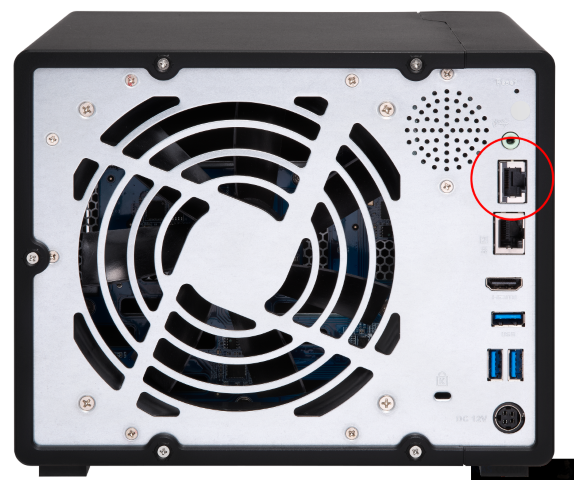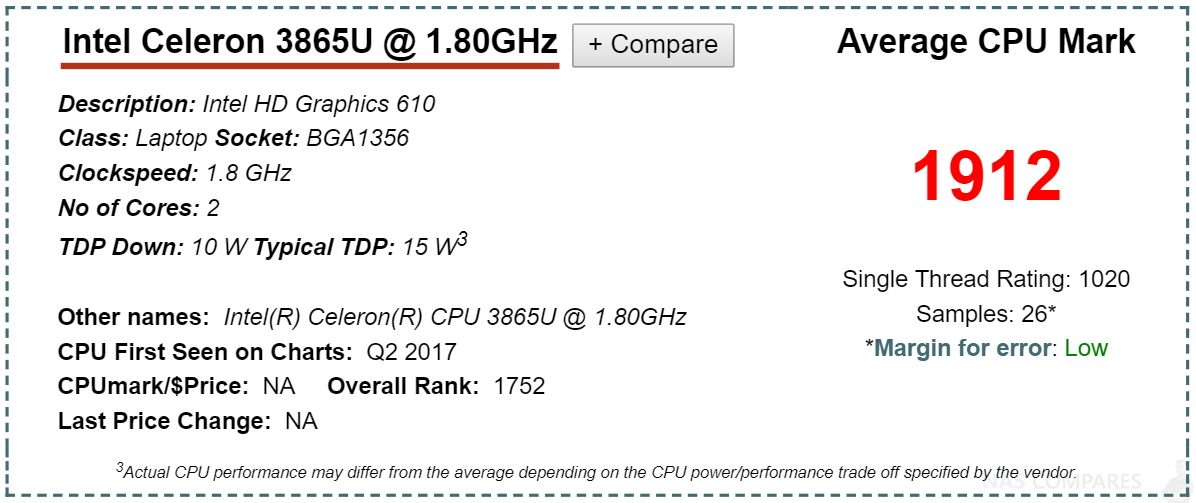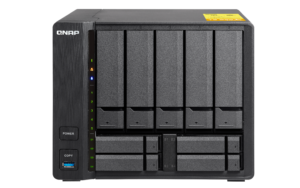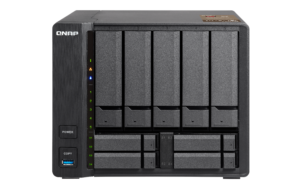The QNAP TVS-951N 5/9-Bay NAS featuring 10GBASE-T for the Home
QNAP NAS have really been busy in Q3 of 2019. Last week we saw the reveal of the new 5Gbe TVS-x72N series and now we have seen the reveal of a new 9-Bay (5 Hard Drive and 4 SSD) based NAS, the TVS-951N. The latest unit to join the growing 5-gigabit ethernet collection features an Intel dual-core processor and HDMI out is a much more appealing purchase for those looking into the affordable network upgrade of 5Gbe over 1Gbe! I say this is a new QNAP NAS, the TVS-951N is a revision of the previously released 10Gbe enabled TVS-951X NAS released late in 2018. Let’s find out what the QNAP TVS-951N has in store for us in 2019 and whether this is just the TVS-951X with a downgrade? I beg to differ, let me explain why.

What are the Specifications of the QNAP TVS-951N 10Gbe NAS
The TVS-951N is cost-effective and suitable for small and medium-sized enterprises (SMBs), as well as home users looking to invest in a media NAS that is 5Gbe enabled. It features the 7th Gen Intel Celeron 3865U 1.8Ghz Dual Core, 9 media bays and a built-in 3-speed 5GBASE-T port, providing x86 powered performance over a 5Gbps connection speed. Four 2.5-inch hard disk slots can install SSDs to enable cache and Qtier technology, as well as be utilized for raw fast storage. The dedicated 5Gbe port (5G/2.5G/1G/100M) allows you to use existing Cat 5e/6 cables to increase file and access speeds, as well as productivity without additional costs, plus with the newly released USB 3.0 to 5Gbe adapter released by QNAP, all you need is an available USB port on your PC/Mac system to take advantage of over 550MB/s performance between your client machine and the host NAS. As well as the additional performance benefits internally of an SSD and HDD based NAS combo. The TVS-951N incorporates multiple QNAP technologies, such as virtual JBOD (VJBOD), Container Station, and Virtualization Station, which can be used in hundreds of business and home applications and can be easily expanded to meet future data storage needs. Below are the specs we know so far:

CPU: 7th Gen Intel Celeron 3865U 1.8Ghz Dual Core
TRANSCODING ENGINE: Intel® HD Graphics 610 – transcoding engine
MEMORY: DDR4 RAM
HARD DRIVE STORAGE: 5 HDD Bays
SOLID STATE STORAGE: 4 SSD Bays
DESIGN: Desktop Chassis, featuring Screw less Trays and LED lights throughout
Ports: 1x 5GbE RJ45, 1x HDMI, 3+1 USB 3 ports, Quick Copy Button, Rear Speaker, Audio Out
SOFTWARE: Plex Media Server Support, 30x Cameras in Surveillance Station, VM use with Virtualisation Station, Container Station, Linux Station and Windows Server Support and more with full app support on QTS.
What makes the TVS-951N so different from other 2019 NAS?
|
TVS-951N
|
HDD Bays
|
5
|
|
SSD Bays
|
4
|
|
| HDMI | 1 | |
| 5GBASE-T | 1 | |
|
RJ45 LAN
|
1
|
|
|
USB 2.0
|
–
|
|
|
USB 3.0
|
4 | |
|
Line output (3.5 mm)
|
1 | |
|
speaker
|
1 |
As mentioned, the TVS-951N features an Intel Celeron 3865U 1.8Ghz Dual Core processor, along with 4GB of DDR4 memory that can be upgraded all the way to 32GB (great news for those looking at virtual environments). The 5Gbe network connectivity is handled by the Aquantia AQtionTM AQC111C controller and there is a 2nd RJ45 port supporting traditional 1Gbe. You can, of course, use the USB to 5gbe adapter with this NAS to turn one or more of those USB 3.0 ports into additional 5Gbe ports too.
|
TVS-951X
|
HDD Bays
|
5
|
|
SSD Bays
|
4
|
|
| HDMI | 1 | |
| 10GBASE-T | 1 | |
|
RJ45 LAN
|
1
|
|
|
USB 2.0
|
–
|
|
|
USB 3.0
|
4 | |
|
Line output (3.5 mm)
|
1 | |
|
speaker
|
1 |
Moving from one form of ethernet to another, we can look at the QNAP TS-932X NAS. On the one hand, it features a much different ARM-based Annapurna Labs CPU, an Alpine AL-324 Quad-core 1.7GHz ARM Cortex-A57 Processor(64-bit) and 2GB DDR4 or 8GB DDR4 (1 x 8GB) via a single 1 x SODIMM (Max. 16GB) slot. This device does not feature HDMI, but does feature two 10Gbe ports via SFP+ (fiber) and is much more centred around file management and business users looking for a fast central repository of their data. It arrives at a lower price point than the TVS-951X and TVS-951N, but does this at the expense of a much lower video/graphical support overall.
|
TS-932X
|
HDD Bays
|
5
|
|
SSD Bays
|
4
|
|
| HDMI | 0 | |
| 10GbE SFP+ | 2 | |
|
RJ45 LAN
|
1
|
|
|
USB 2.0
|
–
|
|
|
USB 3.0
|
3 | |
|
Line output (3.5 mm)
|
1 | |
|
speaker
|
1 |
|
TS-963X
|
HDD Bays
|
5 |
|
SSD Bays
|
4 | |
| HDMI | 0 | |
|
10GBASE-T
|
1 | |
|
RJ45 LAN
|
1 | |
|
USB 2.0
|
2 | |
|
USB 3.0
|
2 | |
|
Line output (3.5 mm)
|
1 | |
|
speaker
|
1 |
When will the QNAP TVS-951N NAS be Released?
Release details are still very thin on the ground at the moment. This new TVS-951N does not have an official release date yet, however, we think it will land in late Q3 or very early Q4 of 2019. The QNAP TVS-951N is the latest in a line next-gen NAS devices from QNAP that arrive with 5Gbe connectivity, at an affordable price point for those that looked at 10Gbe and though “ahh…not quite yet”. We hope to see more information on this NAS in the next month or so and will, of course, update you as soon as we hear more.
📧 SUBSCRIBE TO OUR NEWSLETTER 🔔🔒 Join Inner Circle
Get an alert every time something gets added to this specific article!
This description contains links to Amazon. These links will take you to some of the products mentioned in today's content. As an Amazon Associate, I earn from qualifying purchases. Visit the NASCompares Deal Finder to find the best place to buy this device in your region, based on Service, Support and Reputation - Just Search for your NAS Drive in the Box Below
Need Advice on Data Storage from an Expert?
Finally, for free advice about your setup, just leave a message in the comments below here at NASCompares.com and we will get back to you. Need Help?
Where possible (and where appropriate) please provide as much information about your requirements, as then I can arrange the best answer and solution to your needs. Do not worry about your e-mail address being required, it will NOT be used in a mailing list and will NOT be used in any way other than to respond to your enquiry.
Need Help?
Where possible (and where appropriate) please provide as much information about your requirements, as then I can arrange the best answer and solution to your needs. Do not worry about your e-mail address being required, it will NOT be used in a mailing list and will NOT be used in any way other than to respond to your enquiry.

|
 |
How Much RAM Do You Need in Your NAS?
A Buyer's Guide to Travel Routers - GET IT RIGHT, FIRST TIME
Jonsbo N6 DIY NAS Case Review
The Best Bits (and Worst Bits) of NAS of 2025!
Minisforum MS-02 Ultra Review
Minisforum N5 NAS, 6 Months Later - Better, Worse, the Same?
Access content via Patreon or KO-FI
Discover more from NAS Compares
Subscribe to get the latest posts sent to your email.










does TS-963N support DDR4 memory, in the docs it says DDR3 !!!
REPLY ON YOUTUBE
I am not just bemused but really confused. For years I’ve wanted to step up to 10Gbe and now just when Switches and Infrastructure is arriving at decent prices the marketplace has a bzillion offerings for 2.5 and 5Gbe products. Why on earth would I want to go to them instead of 10Gbe. (And wiring is not an argument, decent copper wiring is fine for 10Gbe or go optical)